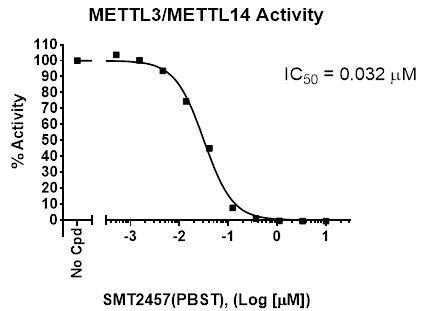METTL3/METTL14 Complex Assay Service
●
Target
METTL3/METTL14
●
Description
Screening and/or profiling inhibitor compounds against METTL3/METTL14 methyltransferase activity in a biochemical assay.
●
Synonyms
Methyltransferase-like 3, METTL3, RNA, METTL14
●
Example Data

*Example only, final data may vary.
Assay Details
●
Assay Format
Chemiluminescent
●
Reference Compounds and IC50
STM2457, 0.032 μM
●
Assay Principle
The METTL3/METTL14 Complex Chemiluminescent Assay is designed to measure METTL3/METTL14 complex activity for screening and profiling applications. The key to the assay is a highly specific antibody that recognizes N6-methylated adenosine. For the assay, only three simple steps are required for methyltransferase detection. First, S-adenosylmethionine is incubated with a sample containing assay buffer and methyltransferase enzyme. Next, a primary antibody is added. Finally, the plate is treated with an HRP-labeled secondary antibody followed by the addition of the HRP substrate to produce chemiluminescence that can then be measured using a chemiluminescence reader.
Target Details
●
Protein Family
Methyltransferases
●
UniProt
METTL3: Q86U44; METTL14: Q9HCE5
●
Background
Mettl3 and Mettl14 are key components of the mRNA m6A methyltransferase complex, playing a crucial role in the regulation of RNA metabolism. These proteins are responsible for catalyzing the addition of methyl groups to adenosine residues in mRNA, a modification known as N6-methyladenosine (m6A). This dynamic RNA modification has emerged as a pivotal regulator of various biological processes, including RNA splicing, stability, and translation. Furthermore, the dysregulation of Mettl3 and Mettl14 has led to increased interest in their potential as therapeutic targets. Modulating the activity of these methyltransferases or targeting the m6A modification machinery holds promise for developing novel therapeutic interventions. Strategies aimed at restoring proper m6A modification patterns could be explored to rectify aberrant gene expression profiles associated with diseases, making Mettl3 and Mettl14 attractive candidates for therapeutic intervention in various pathological conditions.
Delivery
●
Estimated Turnaround
Two to three weeks following delivery of compounds
●
Results
Extensive report with raw and analyzed data, graphs, and detailed protocols. Includes positive control for inhibition.

